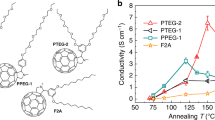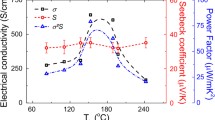Abstract
Organic thermoelectrics offer an alternative to their inorganic counterpart in the pursuit for high ZT materials. While a few PEDOT-related organics has shown significant promise, there is nonetheless a lack of general understanding on the transport mechanism with respect to the carriers and the phonons. This work examined the implication of the Lorentz number approaching one in de-doped PEDOT–PSS (Poly (3,4-ethylene dioxythiophene): Poly(styenesulphonate)) and compared to related properties found in oxidized PEDOT:Tos (poly(3,4-ethylenedioxythiophene-tosylate)). In our analysis, we assumed that the carriers were tightly-coupled to the phonons and their transport properties were basically metallic. Using data reported in the open literature, we computed the Lorentz numbers of the two and showed that there were major differences. For instance, the Lorentz number of oxidized PEDOT:Tos was larger than that of a metal until the organic turned metallic while the Lorentz number of de-doped PEDOT:PSS which persistently was smaller than one. Potentially, the latter would imply a drop in the phonon relaxation time. We attributed the decrease to the formation of a porous structure which reduced the effectiveness in heat transfer.


Similar content being viewed by others
References
G.-H. Kim, L. Shao, K. Zhang, K.P. Pipe, Engineered doping of organic semiconductors for enhanced thermoelectric efficiency. Nat. Mater. 12, 719–723 (2013)
O. Bibnova, Z.U. Khan, A. Malti, S. Braun, M. Fahlman, M. Berggren, X. Crispin, Optimization of the thermoelectric figure of merit in the conducting polymer poly(3,4-ethylenedioxythiophene-tosylate). Nat. Mater. 10, 429–433 (2011)
C. Kittel, Introduction to Solid State Physics, 3rd edn. (Wiley, NY, 1966)
O. Bubnova, Z.U. Khan, H. Wang, S. Braun, D.R. Evans, M. Fabretto, P. Hojati-Talemi, D. Dagnelund, J.-B. Arlin, Y.H. Greets, S. Desbief, D.W. Breiby, J.W. Andreasen, R. Lazzaroni, W.M. Chen, I. Zozoulenko, M. Fahlman, P.J. Murphy, M. Berggren, X. Crispin, Semi-metallic polymers. Nat. Mater. 13, 190–194 (2013)
H.L. Kwok, Thermal conductivity and ZT in disordered organic thermoelectrics. J. Electron. Mater. 42, 355–358 (2013)
H.L. Kwok, Charge mobility and ZT in conducting organic thermoelectric. J. Mater. Sci. Mater. Electron. 23, 2272–2275 (2012)
M.D. Losego, M.E. Grady, N.R. Sottos, D.G. Cahill, P.V. Braun, Effects of chemical bonding on heat transport across interfaces. Nat. Mater. 11, 502–505 (2012)
Acknowledgments
The author appreciates the partial support of NSERC Canada.
Author information
Authors and Affiliations
Corresponding author
Rights and permissions
About this article
Cite this article
Kwok, H.L. Exploring the implications of the Lorentz number approaches one in organic thermoelectrics. J Mater Sci: Mater Electron 26, 830–832 (2015). https://doi.org/10.1007/s10854-014-2471-4
Received:
Accepted:
Published:
Issue Date:
DOI: https://doi.org/10.1007/s10854-014-2471-4




